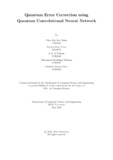| dc.contributor.advisor | Ahmed, Shahnewaz | |
| dc.contributor.advisor | Das, Sowmitra | |
| dc.contributor.author | Mishu, Niloy Deb Roy | |
| dc.contributor.author | Meem, Fatema Islam | |
| dc.contributor.author | Ridwan, A. E. M | |
| dc.contributor.author | Rahman, Mohammad Mushfiqur | |
| dc.contributor.author | Mary, Mekhala Mariam | |
| dc.date.accessioned | 2021-09-03T12:08:43Z | |
| dc.date.available | 2021-09-03T12:08:43Z | |
| dc.date.copyright | 2021 | |
| dc.date.issued | 2021-06 | |
| dc.identifier.other | ID 17301081 | |
| dc.identifier.other | ID 21141074 | |
| dc.identifier.other | ID 17301208 | |
| dc.identifier.other | ID 17301097 | |
| dc.identifier.other | ID 17101368 | |
| dc.identifier.uri | http://hdl.handle.net/10361/14966 | |
| dc.description | This thesis is submitted in partial fulfillment of the requirements for the degree of Bachelor of Science in Computer Science and Engineering, 2021. | en_US |
| dc.description | Cataloged from PDF version of thesis. | |
| dc.description | Includes bibliographical references (pages 39-40). | |
| dc.description.abstract | Quantum computing with its powerful attributes - entanglement and superposition, is revolutionizing modern computation. Moreover, quantum computation can
be applied to a wide range of real-world applications, including cybersecurity and
cryptography, computational chemistry, artificial intelligence, prime factorization,
and so on. However, the biggest impediment of quantum computation is quantum
error. Often the decoherence caused by the environment or any other malfunction
creates quantum errors which can arbitrarily change the state of a quantum system
and destroying its information content - bit flip & phase flip error, unwanted measurement error, etc. A specific Quantum Error Correction (QEC) code can rectify
some particular errors. But, it is usually not optimized for any random error. As
of today, ‘Deep Learning’ techniques in analyzing data have been very promising
which is influencing researchers to apply these methods to ‘Quantum Computation’ problems. We have implemented a Quantum Convolutional Neural Network
(QCNN) using Parameterized Quantum Circuit (PQC) on IBM’s open source Quantum Computing framework QISKIT. The generic structure of the QCNN consists
of variational forms of the encoder and decoder of the error correction code, which
is optimized during training. In this way, it constructs a quantum error correction
method for a certain error model. We were able to retrieve quantum states with as
much as 90% fidelity rate from the experiments. As a result, our model achieves a
high fidelity while using relatively few parameters, which can be generalized for any
error model. | en_US |
| dc.description.statementofresponsibility | Niloy Deb Roy Mishu | |
| dc.description.statementofresponsibility | Fatema Islam Meem | |
| dc.description.statementofresponsibility | A. E. M Ridwan | |
| dc.description.statementofresponsibility | Mohammad Mushfiqur Rahman | |
| dc.description.statementofresponsibility | Mekhala Mariam Mary | |
| dc.format.extent | 40 pages | |
| dc.language.iso | en | en_US |
| dc.publisher | Brac University | en_US |
| dc.rights | Brac University theses are protected by copyright. They may be viewed from this source for any purpose, but reproduction or distribution in any format is prohibited without written permission. | |
| dc.subject | Quantum Computing | en_US |
| dc.subject | Quantum Machine Learning | en_US |
| dc.subject | Qiskit | en_US |
| dc.subject | Deep Neural Network | en_US |
| dc.subject | CNN | en_US |
| dc.subject | QCNN | en_US |
| dc.subject.lcsh | Quantum computing. | |
| dc.title | Quantum error correction using quantum convolutional neural network | en_US |
| dc.type | Thesis | en_US |
| dc.contributor.department | Department of Computer Science and Engineering, Brac University | |
| dc.description.degree | B. Computer Science | |

